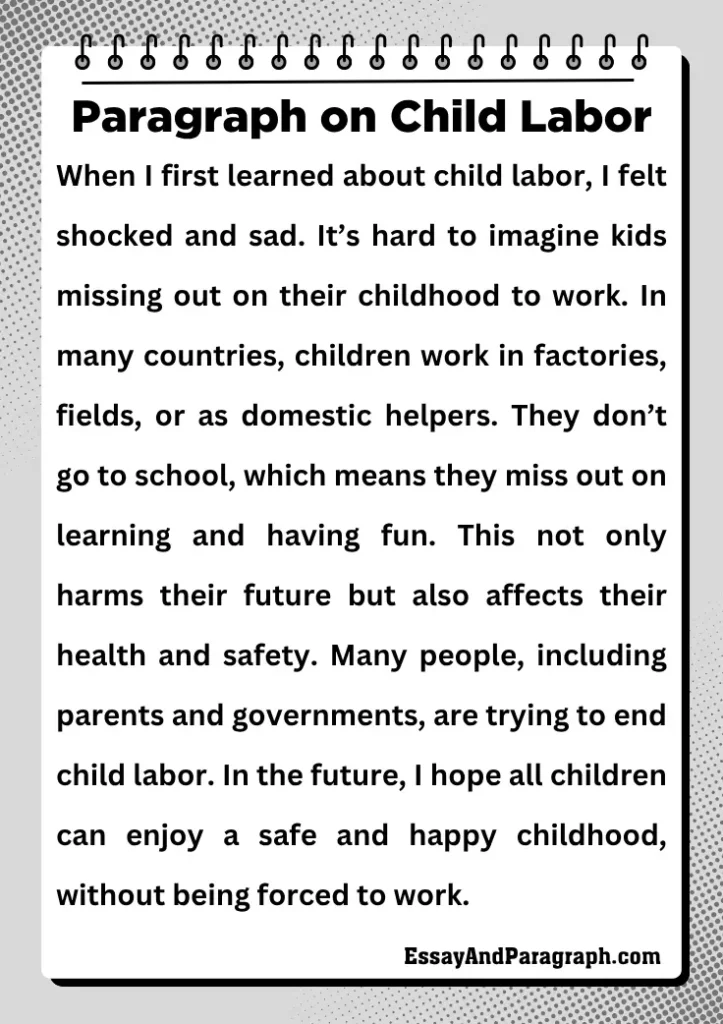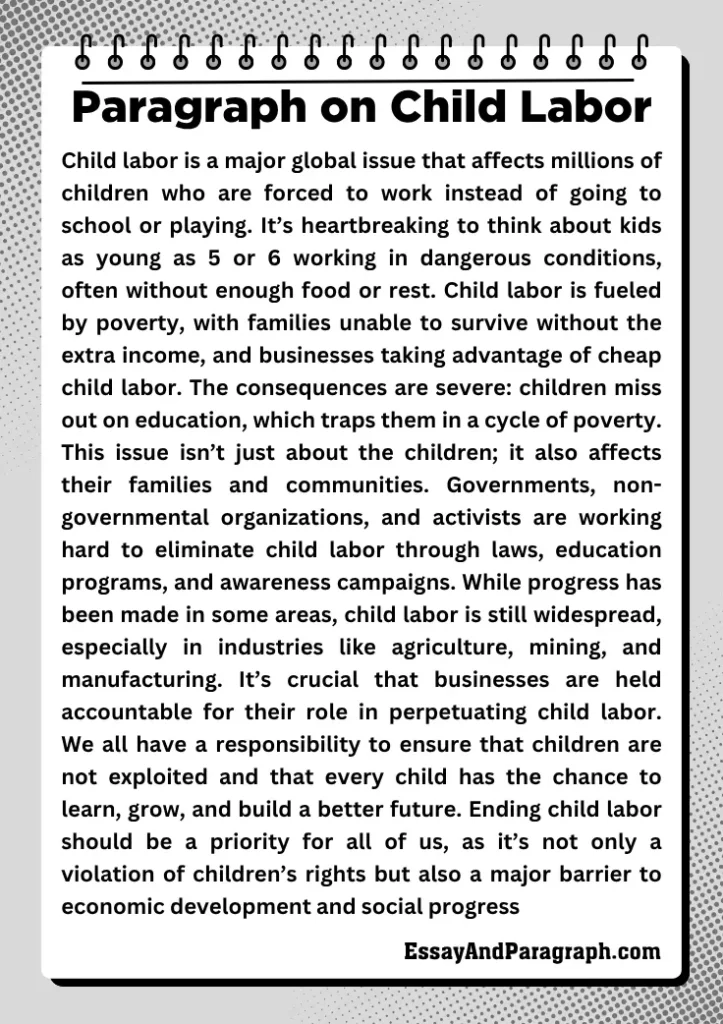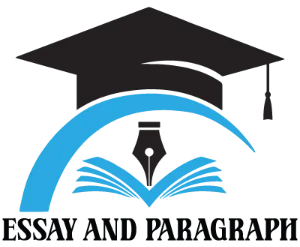Child labor is a critical issue that affects millions of young children around the world. Imagine a child working long hours, unable to play or go to school, simply to help support their family. It’s heartbreaking and unfair. While we may not always see it, child labor happens in many industries, from agriculture to factories. In this article, we will learn how to write about child labor, exploring its impact on children and the world. Whether you’re new to the topic or want to understand it better, we’ll break it down for you. Keep reading to discover how we can stop child labor and protect children’s rights.
Paragraph on Child Labor – 100 words
When I first learned about child labor, I felt shocked and sad. It’s hard to imagine kids missing out on their childhood to work. In many countries, children work in factories, fields, or as domestic helpers. They don’t go to school, which means they miss out on learning and having fun. This not only harms their future but also affects their health and safety. Many people, including parents and governments, are trying to end child labor. In the future, I hope all children can enjoy a safe and happy childhood, without being forced to work.
 Paragraph on Child Labor
Paragraph on Child Labor
Paragraph on Child Labor – 150 words
Child labor is a sad reality that impacts millions of children around the world. When I first read about children working in dangerous conditions, it made me feel deeply upset. These kids don’t have the chance to play or study like others their age. Instead, they are forced to work in harmful environments, often doing jobs that are too hard or unsafe for them. The main people involved are the children, their families, and the companies that hire them. Many countries have laws to prevent child labor, but it still happens in places where laws are not followed. While some organizations work hard to raise awareness and help these children, much more needs to be done. As a society, we must come together to stop child labor, ensuring that all children can have a bright future, full of opportunities.
Paragraph on Child Labor – 200 words
I’ll never forget the first time I read about child labor in a developing country. It was shocking and left me feeling both angry and sad. Children, often no older than 10, were working long hours in hot, dusty factories, or out in the fields, picking crops. Instead of going to school or playing with their friends, these kids were part of a harsh system that stole their childhood. The reasons behind child labor are complex. In many families, children work because their families are poor and can’t survive without the extra income. Sadly, businesses take advantage of this situation, hiring children for low wages to save money. The key people in this situation are the children, their families, and the companies that exploit them. Some children can’t even escape this cycle because they’re born into it. The long-term effects are severe. These children grow up without an education, making it harder for them to break the cycle of poverty. There is hope, though. Governments, NGOs, and activists are working to end child labor, but it will take time. We all need to work together to make sure that no child is forced to miss out on the education and joy they deserve.
Paragraph on Child Labor – 250 words
When I think about child labor, I feel a deep sense of sadness and frustration. How can children, who are supposed to be learning and growing, end up working in dangerous and unfair conditions? Sadly, this is the reality for millions of kids around the world. I first learned about this issue while reading about children working in mines and factories. These kids wake up every day, not to go to school, but to work in hot, noisy, and sometimes life-threatening environments. What shocked me the most was how many of these children are as young as 5 or 6 years old. It’s hard to imagine what their childhood must be like. Many of them work for long hours, often with little rest or food. And because they’re forced to work instead of go to school, they miss out on the education that could change their lives. The main people involved in child labor are the children themselves, the families who feel they have no other choice but to send their kids to work, and the businesses that hire them. The result is a cycle of poverty and hardship. Children who are forced into labor grow up without the skills needed to get a good job, which keeps them trapped in a life of struggle. While there have been improvements in some areas, we still have a long way to go. I hope that through awareness and collective action, we can make child labor a thing of the past, ensuring a bright future for every child.
Paragraph on Child Labor – 300 words
Child labor is one of the most heartbreaking issues facing the world today. It’s hard to fathom how millions of children are forced to work instead of going to school, playing with their friends, and enjoying their childhood. I first learned about child labor when I read about children working in sweatshops, making clothes for major brands. It made me feel angry and sad at the same time. These kids are often exposed to dangerous chemicals, long hours, and even physical abuse. Instead of having the chance to learn and grow, they are pushed to work in unhealthy conditions that can ruin their future. What struck me the most was how common this practice is in many developing countries. Many children work in agriculture, mining, and manufacturing, earning very little for their families. The emotional toll on these kids is immense. They are deprived of their right to education and the opportunity to dream big. But it’s not just the children who suffer. Their families are often trapped in poverty and feel they have no choice but to send their kids to work. The companies that hire child laborers benefit from low wages and high profits, but they’re also part of the problem. Over the years, many organizations and governments have worked to reduce child labor through laws, education programs, and awareness campaigns. The progress is slow, but change is happening. However, we need more efforts, especially from businesses that use child labor in their supply chains. In the future, I hope we will see an end to this injustice, with every child having access to education, safety, and a chance to build a better life.
FAQs on Paragraph on Child Labor
What is child labor?
Child labor is the practice of employing children under the legal working age, often in dangerous, unhealthy, or exploitative conditions. These children miss out on education and are forced to work in industries like agriculture, mining, and factories.
Why is child labor a problem?
Child labor deprives children of their childhood, education, and future opportunities. It also perpetuates cycles of poverty, as children who work instead of learning are unable to secure better jobs later in life.
How can child labor be stopped?
Stopping child labor requires a combination of laws, education, and awareness. Governments must enforce child labor laws, businesses must take responsibility for their supply chains, and communities must raise awareness to prevent child exploitation.
What industries use child labor?
Child labor is found in various industries, including agriculture, manufacturing, mining, and domestic work. It is particularly common in developing countries where poverty rates are high.
What can individuals do to help end child labor?
Individuals can help by supporting companies that have ethical labor practices, donating to organizations that fight child labor, and raising awareness about the issue through social media and conversations.
 Paragraph on Child Labor
Paragraph on Child Labor
Summary on Child Labor
Child labor is a major global issue that affects millions of children who are forced to work instead of going to school or playing. It’s heartbreaking to think about kids as young as 5 or 6 working in dangerous conditions, often without enough food or rest. Child labor is fueled by poverty, with families unable to survive without the extra income, and businesses taking advantage of cheap child labor. The consequences are severe: children miss out on education, which traps them in a cycle of poverty. This issue isn’t just about the children; it also affects their families and communities. Governments, non-governmental organizations, and activists are working hard to eliminate child labor through laws, education programs, and awareness campaigns. While progress has been made in some areas, child labor is still widespread, especially in industries like agriculture, mining, and manufacturing. It’s crucial that businesses are held accountable for their role in perpetuating child labor. We all have a responsibility to ensure that children are not exploited and that every child has the chance to learn, grow, and build a better future. Ending child labor should be a priority for all of us, as it’s not only a violation of children’s rights but also a major barrier to economic development and social progress.

